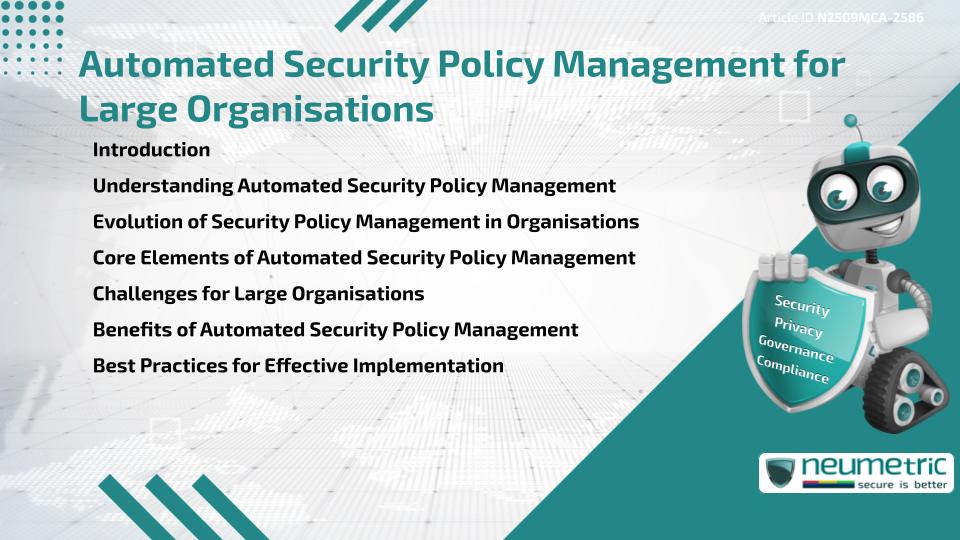Table of Contents
ToggleIntroduction
Automated Security Policy Management is increasingly vital for large organisations that face complex Regulatory & Operational requirements. With diverse IT Infrastructures, Cloud Platforms & Distributed Workforces, maintaining consistent Security Policies manually is nearly impossible. Automation enables Centralised Oversight, reduces errors & strengthens Compliance. Without it, organisations Risk Misconfigurations, Vulnerabilities & Costly Breaches. This article explains what Automated Security Policy Management is, how it evolved, its challenges, benefits & best practices for effective adoption.
Understanding Automated Security Policy Management
Automated Security Policy Management refers to the use of Software Tools & Frameworks that automatically enforce, monitor & update Security Policies across Enterprise Systems. Much like traffic lights regulate Vehicles consistently across a city, Automation ensures Security rules are applied uniformly across Devices, Networks & Applications. It provides Enterprises with Real-time visibility & reduces human dependency in managing complex Environments.
Evolution of Security Policy Management in Organisations
In the past, organisations relied on Manual Configurations & Spreadsheets to track Compliance. As digital Infrastructures expanded, Manual Processes became inefficient & prone to Errors. CyberSecurity Incidents caused by Misconfigured Firewalls or Outdated Access Controls highlighted the Limitations of Traditional Methods. Frameworks such as ISO 27001 & The NIST CyberSecurity Framework encouraged Structured approaches, paving the way for Automated Tools to ensure Continuous Compliance & Security.
Core Elements of Automated Security Policy Management
Key Components include:
- Centralised Control: Defining & Managing Policies from a Single Platform.
- Real-Time Monitoring: Tracking Compliance & Detecting Anomalies instantly.
- Automated Enforcement: Applying rules across Systems without manual intervention.
- Audit & Reporting: Generating Logs & Compliance Reports automatically.
- Integration: Connecting with existing Enterprise Systems for seamless Operation.
These elements ensure that Security Policies are both consistent & adaptable to evolving Risks.
Challenges for Large Organisations
Large organisations face unique hurdles in implementing Automated Security Policy Management. Diverse IT Ecosystems, Spanning Cloud, On-premise & Hybrid Models, create integration complexity. Legacy Systems may not support modern Automation Tools, requiring costly upgrades. Resistance to change from Employees & High initial Investment Costs also pose obstacles. Additionally, Global organisations must address varying Regulatory requirements across regions.
Benefits of Automated Security Policy Management
Adopting Automated Security Policy Management delivers significant advantages. It reduces Risks by eliminating Human Error, ensures Compliance with Industry Standards & Improves Operational efficiency. Automation also speeds up Incident Response & Provides reliable Audit Trails for Regulators. Much like autopilot in aviation improves safety & consistency, Automation in Security Policy Management enhances control & reduces Vulnerabilities.
Best Practices for Effective Implementation
To implement Automation effectively, organisations should:
- Conduct a thorough Assessment of existing Policies & Systems.
- Choose scalable Tools that integrate with Multi-cloud & Hybrid Environments.
- Train staff to adapt to Automated processes.
- Establish Continuous Monitoring & Regular Reviews.
- Align Automation strategies with Regulatory Frameworks such as ISO 27001 or GDPR.
Embedding these practices ensures that Automation enhances both Security & Compliance in large organisations.
Conclusion
Automated Security Policy Management empowers large organisations to manage complexity, strengthen Compliance & Minimise Risks. While challenges exist, the benefits of consistency, efficiency & resilience make Automation a cornerstone of modern Enterprise Security Strategies.
Takeaways
- Automated Security Policy Management ensures consistency across complex Infrastructures.
- Core elements include Centralised control, monitoring, enforcement & reporting.
- Challenges involve integration complexity, Legacy Systems & Global Regulations.
- Benefits include reduced errors, faster response & improved Compliance.
- Best Practices embed Automation into Enterprise Culture & Governance.
FAQ
What is Automated Security Policy Management?
It is the use of Automated Tools to enforce, monitor & update Security Policies across Enterprise Systems.
Why do large organisations need Automation in policy Management?
Because manual processes are Error-prone & Inefficient for large, complex Infrastructures.
What challenges arise in adopting Automation?
Challenges include integration with Legacy Systems, High Costs & Varying Regulations across regions.
How does Automation improve Compliance?
It ensures consistent Application of rules, generates Audit-ready reports & reduces Human error.
What Best Practices support successful adoption?
Organisations should assess existing Systems, Train Staff, choose Scalable Tools & Align with Regulatory Frameworks.
References
- ISO 27001 Information Security Standard
- NIST CyberSecurity Framework
- General Data Protection Regulation (GDPR)
- ENISA Guidance on CyberSecurity
- World Economic Forum on CyberSecurity
Need help for Security, Privacy, Governance & VAPT?
Neumetric provides organisations the necessary help to achieve their CyberSecurity, Compliance, Governance, Privacy, Certifications & Pentesting needs.
Organisations & Businesses, specifically those which provide SaaS & AI Solutions in the Fintech, BFSI & other regulated sectors, usually need a CyberSecurity Partner for meeting & maintaining the ongoing Security & Privacy needs & requirements of their Enterprise Clients & Privacy conscious Customers.
SOC 2, ISO 27001, ISO 42001, NIST, HIPAA, HECVAT, EU GDPR are some of the Frameworks that are served by Fusion – a SaaS, multimodular, multitenant, Centralised, Automated, CyberSecurity & Compliance Management System.
Neumetric also provides Expert Services for technical Security which covers VAPT for Web Applications, APIs, iOS & Android Mobile Apps, Security Testing for AWS & other Cloud Environments & Cloud Infrastructure & other similar scopes.
Reach out to us by Email or filling out the Contact Form…


